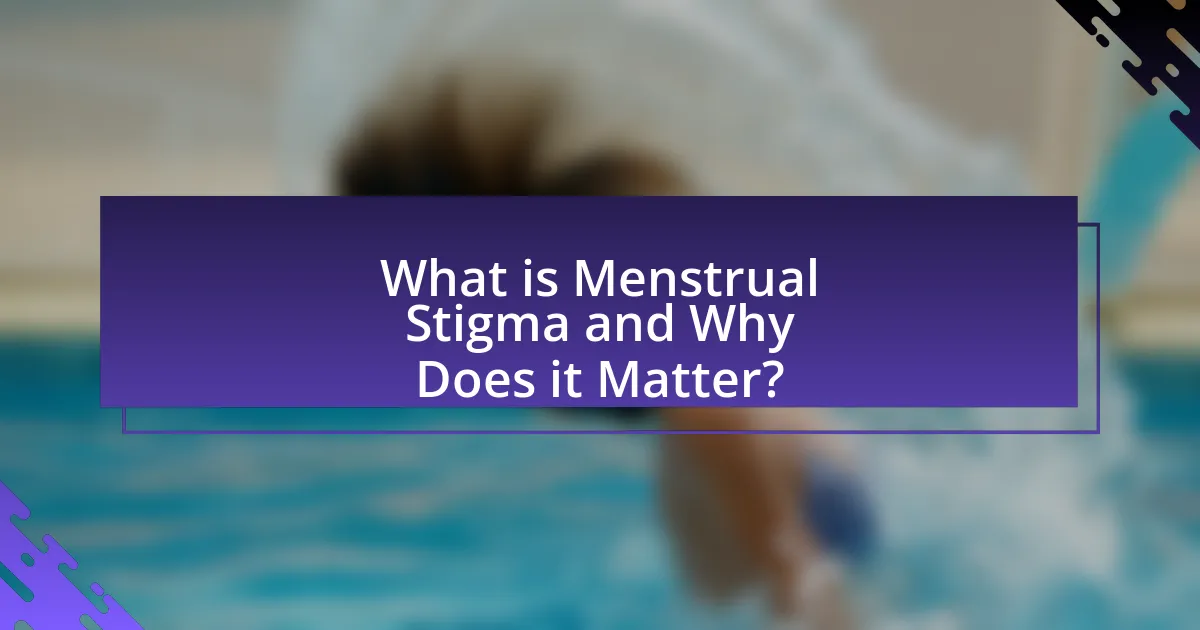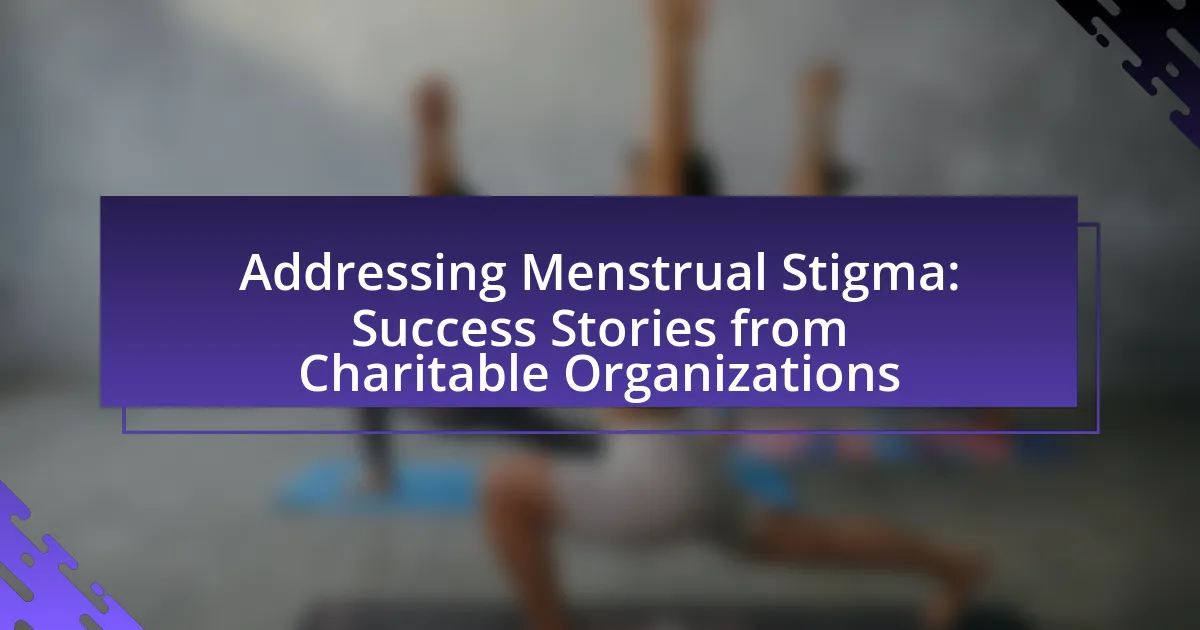Menstrual stigma encompasses the negative attitudes and beliefs surrounding menstruation, leading to discrimination and shame for those who menstruate. This article examines the impact of menstrual stigma on health, education, and gender equality, highlighting its cultural variations and historical roots. It also explores common misconceptions, the role of education in dispelling these myths, and the initiatives launched by charitable organizations to combat stigma. Success stories from organizations like Days for Girls illustrate the effectiveness of educational programs and product distribution in improving access to menstrual health resources and fostering community acceptance. The article emphasizes the importance of continued efforts to address menstrual stigma and promote gender equality globally.

What is Menstrual Stigma and Why Does it Matter?
Menstrual stigma refers to the negative attitudes, beliefs, and taboos surrounding menstruation, which can lead to discrimination and shame for those who menstruate. This stigma matters because it affects individuals’ mental and physical health, limits access to menstrual hygiene products, and perpetuates gender inequality. Research indicates that in many cultures, menstruation is associated with shame and secrecy, which can hinder open discussions and education about menstrual health, ultimately impacting the well-being of millions. For instance, a study published in the journal “BMC Women’s Health” found that menstrual stigma can lead to increased absenteeism in schools and workplaces, highlighting the broader societal implications of this issue.
How is menstrual stigma defined in different cultures?
Menstrual stigma is defined as the negative attitudes, beliefs, and practices surrounding menstruation that vary significantly across cultures. In many societies, menstruation is associated with shame and secrecy, leading to restrictions on women’s participation in daily activities, such as religious practices or social gatherings. For instance, in some cultures in India, menstruating women are often considered impure and are isolated from family members, reflecting deep-rooted taboos. Conversely, in cultures like the Navajo Nation, menstruation is viewed as a natural and sacred process, with rituals that celebrate it. This cultural variability highlights how menstrual stigma can either reinforce gender inequality or promote empowerment, depending on societal beliefs and practices.
What are the historical roots of menstrual stigma?
The historical roots of menstrual stigma stem from cultural, religious, and societal beliefs that have historically viewed menstruation as impure or shameful. In many ancient societies, such as those in Greece and Rome, menstruating women were often isolated or considered unclean, leading to the development of taboos surrounding menstruation. For instance, in some religious texts, menstruation is associated with sin or impurity, reinforcing negative perceptions. This stigma has persisted over centuries, influencing modern attitudes and practices regarding menstruation, as evidenced by ongoing challenges in menstrual health education and access to menstrual products.
How does menstrual stigma impact women’s health and well-being?
Menstrual stigma negatively impacts women’s health and well-being by contributing to feelings of shame, isolation, and anxiety surrounding menstruation. This stigma can lead to inadequate access to menstrual hygiene products, as women may avoid seeking help or discussing their needs due to fear of judgment. Research indicates that in regions where menstrual stigma is prevalent, such as parts of South Asia and Africa, girls often miss school during their periods, which can hinder their education and future opportunities. A study published in the journal “BMC Women’s Health” found that 23% of girls in India reported missing school due to menstruation, highlighting the direct correlation between stigma and educational disruption. Furthermore, the psychological effects of menstrual stigma can lead to increased stress and lower self-esteem, ultimately affecting overall mental health.
What are the common misconceptions surrounding menstruation?
Common misconceptions surrounding menstruation include the belief that menstruation is dirty or shameful, that women cannot participate in sports or physical activities during their period, and that menstrual cycles are always regular and predictable. These misconceptions perpetuate stigma and misinformation. For instance, research indicates that many cultures view menstruation as impure, leading to social exclusion during this time. Additionally, studies show that women can engage in sports without any adverse effects during menstruation, contradicting the notion that physical activity should be avoided. Furthermore, while some women experience regular cycles, others may have irregularities due to various factors, including hormonal imbalances or health conditions, highlighting the diversity of menstrual experiences.
How do these misconceptions contribute to stigma?
Misconceptions about menstruation contribute to stigma by perpetuating negative beliefs and attitudes towards individuals who menstruate. These misconceptions often include the idea that menstruation is dirty or shameful, leading to social exclusion and discrimination. For instance, a study published in the journal “BMC Women’s Health” found that 70% of women in certain regions reported feeling embarrassed about their periods due to societal beliefs, which reinforces stigma and hinders open discussions about menstrual health. This stigma can result in reduced access to menstrual products and education, further entrenching the cycle of misinformation and shame surrounding menstruation.
What role does education play in dispelling these myths?
Education plays a crucial role in dispelling myths surrounding menstrual stigma by providing accurate information and fostering open dialogue. By teaching individuals about the biological, social, and cultural aspects of menstruation, educational initiatives challenge misconceptions and promote understanding. For instance, programs implemented by charitable organizations have demonstrated that when communities receive comprehensive menstrual education, there is a significant reduction in stigma and shame associated with menstruation. Research indicates that in areas where menstrual health education is prioritized, such as in initiatives by organizations like Days for Girls, there is a marked increase in girls’ school attendance and participation, illustrating the direct impact of education on societal attitudes towards menstruation.

How are Charitable Organizations Addressing Menstrual Stigma?
Charitable organizations are addressing menstrual stigma by implementing educational programs, distributing menstrual products, and advocating for policy changes. For instance, organizations like Days for Girls provide menstrual hygiene education and reusable products to girls in underserved communities, which helps to break the silence and shame surrounding menstruation. Additionally, initiatives such as the Menstrual Health Hub promote awareness and provide resources to combat stigma, emphasizing that menstruation is a natural biological process. These efforts are supported by research indicating that education and access to menstrual products significantly reduce stigma and improve health outcomes for menstruators.
What initiatives have been launched by charitable organizations?
Charitable organizations have launched various initiatives aimed at addressing menstrual stigma, including educational programs, distribution of menstrual hygiene products, and advocacy campaigns. For example, organizations like Days for Girls provide reusable menstrual kits and education to girls in underserved communities, helping to break the stigma surrounding menstruation and ensuring that girls can attend school during their periods. Additionally, initiatives such as the Menstrual Health Hub promote awareness and policy change regarding menstrual health, highlighting the importance of menstrual hygiene management in public health discussions. These efforts are supported by research indicating that access to menstrual products and education significantly improves the well-being and educational outcomes for menstruators.
How do these initiatives vary across different regions?
Initiatives addressing menstrual stigma vary significantly across different regions due to cultural, economic, and social factors. For instance, in South Asia, organizations often focus on educational campaigns to combat deep-rooted taboos, while in Western countries, initiatives may emphasize product accessibility and policy advocacy. A study by the Menstrual Health Alliance in 2021 highlighted that in Africa, local NGOs prioritize community engagement and distribution of menstrual hygiene products, reflecting the unique challenges faced in that region. These variations demonstrate how local contexts shape the strategies employed by charitable organizations to effectively address menstrual stigma.
What partnerships have been formed to combat menstrual stigma?
Partnerships formed to combat menstrual stigma include collaborations between organizations like Period, which partners with brands such as Thinx and Always, and initiatives like the Menstrual Health Hub, which connects various NGOs and health organizations globally. These partnerships aim to raise awareness, provide education, and distribute menstrual products to underserved communities, thereby addressing the stigma surrounding menstruation. For instance, the collaboration between Period and Thinx has led to the distribution of menstrual products in schools, helping to reduce absenteeism among menstruating students.
What strategies are most effective in reducing menstrual stigma?
Education and awareness campaigns are the most effective strategies in reducing menstrual stigma. These initiatives aim to inform communities about menstruation, dispel myths, and promote open discussions. For instance, organizations like Days for Girls have successfully implemented educational programs that not only provide menstrual hygiene products but also educate individuals about menstrual health, leading to increased acceptance and reduced stigma. Research indicates that communities engaged in such educational efforts experience a significant decrease in negative attitudes towards menstruation, as evidenced by a study published in the Journal of Adolescent Health, which found that comprehensive menstrual education improved knowledge and reduced stigma in participating schools.
How do awareness campaigns influence public perception?
Awareness campaigns significantly influence public perception by educating individuals about specific issues, thereby altering attitudes and behaviors. For instance, campaigns addressing menstrual stigma have successfully increased understanding and reduced shame associated with menstruation, as evidenced by studies showing that communities exposed to such campaigns report higher levels of acceptance and support for menstrual health initiatives. Research conducted by the Menstrual Health Hub indicates that targeted awareness efforts can lead to a 30% increase in positive attitudes towards menstruation within a year, demonstrating the effectiveness of these campaigns in reshaping societal views.
What role do community engagement and education play?
Community engagement and education play a crucial role in addressing menstrual stigma by fostering awareness and promoting understanding within communities. Engaging community members through workshops, discussions, and outreach initiatives helps to dismantle misconceptions surrounding menstruation, thereby reducing stigma. For instance, organizations like Days for Girls have successfully implemented educational programs that empower individuals with knowledge about menstrual health, leading to increased acceptance and support. Research indicates that informed communities are more likely to advocate for menstrual health resources, demonstrating the effectiveness of education in driving social change.

What Success Stories Highlight the Impact of Charitable Organizations?
Charitable organizations have significantly impacted menstrual stigma through various successful initiatives. For instance, the organization Days for Girls has provided over 1 million menstrual kits to girls in need across 125 countries, enabling them to attend school and participate in daily activities without interruption. Additionally, the non-profit organization She’s the First has empowered girls in low-income countries by providing scholarships and menstrual health education, resulting in increased school attendance and improved health outcomes. These success stories illustrate how targeted efforts by charitable organizations can effectively address menstrual stigma and promote gender equality.
What are some notable success stories from specific organizations?
One notable success story is that of Days for Girls, an organization that has provided over 1.5 million menstrual health kits to girls in need across more than 100 countries. This initiative has significantly improved school attendance and educational outcomes for girls, as access to menstrual hygiene products directly correlates with their ability to stay in school during menstruation. Another example is the organization Period, which has successfully advocated for the removal of the tampon tax in several U.S. states, thereby increasing access to menstrual products for low-income individuals. Their efforts have raised awareness about menstrual stigma and led to policy changes that support menstrual equity.
How have these stories changed perceptions in their communities?
These stories have significantly changed perceptions in their communities by fostering open discussions about menstruation and reducing stigma. Charitable organizations have implemented educational programs that inform community members about menstrual health, leading to increased awareness and acceptance. For instance, initiatives that distribute menstrual products and provide workshops have empowered women and girls, resulting in a shift towards viewing menstruation as a natural and normal biological process rather than a taboo subject. This change is evidenced by surveys indicating that communities involved in these programs report a decrease in negative attitudes and misconceptions surrounding menstruation, thereby promoting gender equality and improving overall health outcomes.
What measurable outcomes have resulted from these initiatives?
The measurable outcomes from initiatives addressing menstrual stigma include increased access to menstrual products, improved educational attendance among girls, and enhanced awareness of menstrual health. For instance, organizations like Days for Girls reported that their programs have provided over 1.5 million menstrual kits, leading to a 20% increase in school attendance among girls in regions where these kits were distributed. Additionally, surveys conducted by various charities indicate that 85% of participants reported a better understanding of menstrual health after engaging in educational workshops. These outcomes demonstrate the tangible impact of initiatives aimed at reducing menstrual stigma.
How can these success stories inspire further action?
Success stories from charitable organizations addressing menstrual stigma can inspire further action by demonstrating effective strategies and tangible outcomes. For instance, organizations like Days for Girls have successfully provided menstrual hygiene kits and education, leading to increased school attendance among girls in various regions. This evidence shows that targeted interventions can significantly reduce stigma and improve access to menstrual health resources. By showcasing these successes, other organizations and stakeholders are encouraged to adopt similar approaches, fostering a collaborative effort to tackle menstrual stigma globally.
What lessons can be learned from these successful initiatives?
Successful initiatives addressing menstrual stigma demonstrate the importance of community engagement and education. These programs effectively reduce stigma by involving local leaders and educating both men and women about menstrual health, which fosters a supportive environment. For instance, organizations that have implemented workshops and awareness campaigns report significant increases in community understanding and acceptance, leading to improved access to menstrual products and health services. Evidence from studies shows that when communities are actively involved, the initiatives are more sustainable and impactful, as seen in programs across various countries that have successfully changed perceptions and behaviors related to menstruation.
How can individuals contribute to the fight against menstrual stigma?
Individuals can contribute to the fight against menstrual stigma by openly discussing menstruation and advocating for menstrual health education. Engaging in conversations helps normalize the topic, reducing shame and misinformation surrounding it. Research indicates that stigma can lead to negative health outcomes, as seen in a study published in the Journal of Adolescent Health, which found that lack of education on menstruation can hinder young people’s understanding and management of their menstrual health. By sharing personal experiences and supporting initiatives that promote menstrual awareness, individuals can foster a more inclusive environment that empowers those affected by menstrual stigma.
What are the best practices for organizations addressing menstrual stigma?
Organizations addressing menstrual stigma should implement comprehensive education and awareness programs. These programs should focus on dispelling myths and providing accurate information about menstruation, which can significantly reduce stigma. For instance, research indicates that educational interventions can lead to increased knowledge and positive attitudes towards menstruation among both genders, as evidenced by a study published in the Journal of Adolescent Health, which found that comprehensive menstrual education improved perceptions and reduced stigma in school settings. Additionally, organizations should foster open dialogue by creating safe spaces for discussions about menstruation, encouraging individuals to share their experiences without fear of judgment. This approach has been shown to enhance community support and understanding, further mitigating stigma. Lastly, partnering with local communities to distribute menstrual products and resources can help normalize menstruation and ensure access, as demonstrated by initiatives like the “Period Poverty” campaigns, which have successfully raised awareness and provided support in various regions.



